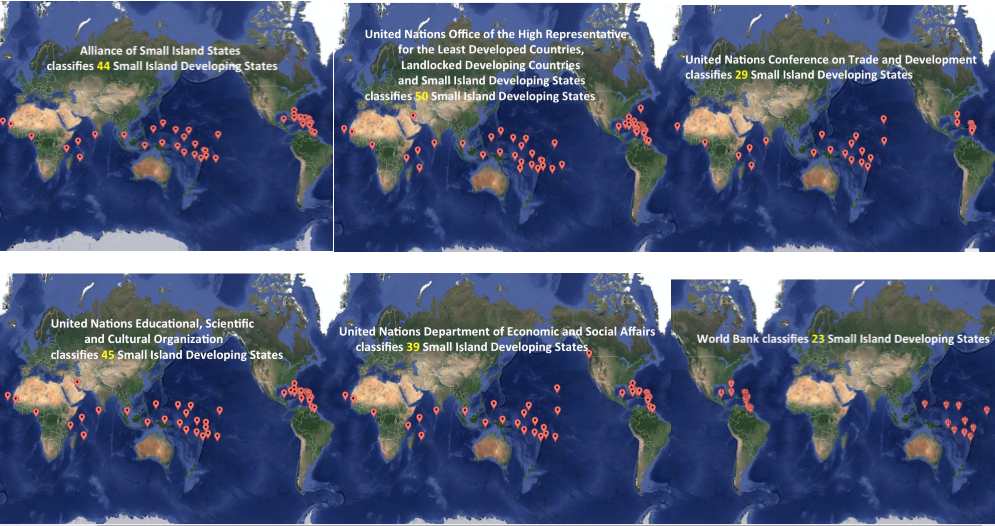Joining-up data standards post-OGP15: a need for joined-up conversations
By Tom Orrell at Publish What You Fund & Joni Hillman at the IATI Secretariat and Development Initiatives
Have you ever taken a train in Spain? Driven from Belfast to Dublin? Or packed the wrong adaptor for a business trip? If so, you may have noticed that standards are persistent. Spanish railways have been built to a different gauge from the rest of Europe since 1845. It took the Republic of Ireland 30 years to switch from miles to kilometres. Liberia, Guinea and Sierra Leone are neighbours but each uses a different shape of plug.
Data standards are less visible, but suffer from a similar problem: different standards mean you can describe the same thing in different, often inconsistent, ways. Take a simple example: how many small island states are there in the world? It turns out there are at least six different answers, ranging from 23 to 50, depending on who you ask.

1: Slides from Conrad Zellmann’s presentation depicting the divergence in definitions of small island states between major international institutions
On 28 October 2015, we co-organised an event on joined-up data standards at the Open Government Partnership Summit (OGP15) in Mexico City. Through a series of lightening talks moderated by Martin Tisné of the Omidyar Network: Ania Calderon from the Government of Mexico, Georg Neumann from the Open Contracting Partnership, Conrad Zellmann from Development Initiatives and Rupert Simons from Publish What You Fund explored the value that joining-up data standards can create for open data standard setters, producers and users alike.
As first-time OGPers, what struck us both about the event was just how much of a need for joined-up conversations between major open data standard-setters (including IATI, Open Contracting, HXL, and others), data producers and users there currently is. In 2015, the need for joined-up conversations has intensified as a result of the exciting policy developments taking place at the international level. Within the context of the renewal of the international development agenda and the setting of the Sustainable Development Goals (SDGs), a rare phenomenon has occurred – a multi-stakeholder consensus across public policy and open data communities has emerged – recognising a need not just for more and better data generation but for the creation of better information to drive policy-making and accountability efforts in future.
Joining-up existing open data standards across policy sectors is only one small component of broader efforts to create better information, but it is a key component. Its value has been acknowledged at the highest levels of the international development community and the need for interoperability is recognised within the Addis Ababa Action Agenda (AAAA) (para. 128). Moreover, within the broader context of the Data Revolution, the need to ensure interoperability and compatibility between data standards has been enshrined as a fundamental open data principle within the new International Open Data Charter (IODC) (Principle 4).
Translating these principles into a more practical example at last week’s event, Georg framed the value of joined-up data as being, “relevant to so many of the SDGs in helping us to follow the money through contracts, aid and budgets”. Linked to this example, Beata Lisowska, a Data Scientist at Development Initiatives working on joined-up data standards, has recently mapped the relationship between sector definitions within the classification of functions of government (COFOG) standard, used by the UN system, and the creditor reporting system (CRS), used by the OECD. Excitingly, this cross-mapping, if linked to SDG indicators, could eventually be used as a tool to estimate whether or not SDG goals are being sufficiently funded.
Now that consensus on the need has been achieved, it is crucial that conversations across interest-groups and policy sectors are joined-up to generate consensus on how interoperability can be achieved. As Conrad put it, “we want to be able to translate between existing standards to make data comparable and speak the same language in key areas – i.e. to make data interoperable”. This implies that standard setters, data producers and users all have to take part in the same conversation. Reflecting on her own experiences, Ania commented that, “in Mexico, we partnered national statistics institutions and the open data community to help join-up data”. This is no mean feat given the divergence in methodologies, objectives and incentives that exist, even within a single government. The politics inherent to joining-up data standards was identified almost immediately at the event, and one of the very first questions from the audience was, “how do you overcome politics to join-up data standards?” In answering the question, Rupert pointed out that the only way to do this is to, “build a coalition of parties who gain from interoperability”. Achieving this will require fostering a new global consensus.
The recognition of the need for interoperable data standards within the IODC and the AAAA offers intergovernmental and multilateral bodies, individual governments, corporate bodies and civil society organisations a unique opportunity to join-up their conversations. As Martin so eloquently put it, “data sings when it is joined-up”. The challenge moving forward then is for open data standard setters, producers and users to put their voices together to make the data sing.